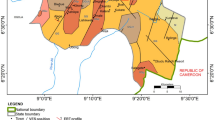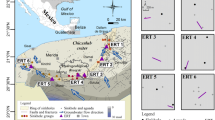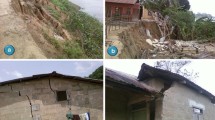Abstract
It is suggested that in a localized remnant of Kalahari sand at Dufuya, central Zimbabwe, groundwater flows in an integrated pattern inherited from the paleochannel network of the underlying gneiss. Contact springs occur at discrete localities along the Kalahari sand/gneiss boundary and are associated with spring sapping and land surface subsidence. Subsidence is presumed to be due to preferential solute removal by leaching and dissolution as a result of concentration of groundwater flow within the buried paleochannel network and the location of the springs is presumed to occur where the paleochannel network intersects the Kalahari sand/gneiss boundary. Over time the surficial Kalahari sand is preferentially removed along these buried drainage lines by spring sapping and headwards erosion, exposing the gneiss. Multi-electrode direct current resistivity profiling and radar have been used to map the sub-surface, revealing the topography of the basement and nature of the Kalahari cover. Coincidence of gneiss basement depressions with the spring sites, leached sands and subsidence zones suggests inheritance of the gneiss fluvial paleochannel network pattern by the present day groundwater flow. Washed sand and gravel intersected in shallow boreholes in these areas provides further evidentiary support for the concept of inherited drainage.
Résumé
On a montré que dans un dépôt de sable du Kalahari localisé à Dufuya, Centre du Zimbabwe, la nappe s’écoule dans un réseau général hérité du réseau de paléochenaux du gneiss sous-jacent. Des sources de contact s’échelonnant le long de la limite sable / gneiss sont associées à des fouilles et subsidences du terrain. La subsidence est vraisemblablement due au lessivage et à une dissolution sélective par l’eau accumulée dans le réseau de paléochenaux et l’on suppose que les sources se trouvent là où le réseau de paléochenaux recoupe la limite gneiss / sable du Kalahari. Au cours du temps, la couverture de sable Kalahari a été érodée de façon préférentielle le long des lignes de drainage souterrain par la fouille et par l’érosion régressive des sources, laissant le gneiss affleurer. Profils de résistivité multipôles et radar ont été utilisés pour cartographier la subsurface, révélant la topographie du substrat et la nature de la couverture Kalahari. La coïncidence de dépression du substrat gneissique avec les emplacements de sources, des sables érodés et zones de subsidence suggèrent que l’écoulement souterrain actuel a hérité du réseau de paléochenaux gneissiques. Sable érodé et gravier recoupés par des sondages superficiels dans ces zones confortent encore d’avantage le concept de drainage hérité.
Resumen
Se sugiere que en un remanente localizado de las arenas de Kalahari en Dufuya, Zimbabwe central, el agua subterránea fluye en una forma heredada de una red de un paleocanal en un gneis subyacente. Existen manantiales de contacto en distintas localidades a través del límite entre gneis / arena de Kalahari y están asociados con manantiales agotados y subsidencia de la superficie del terreno. La subsidencia se supone que es debido a una remoción preferencial por lixiviado del soluto y disolución como resultado de la concentración del flujo subterráneo donde la red de paleocanales intersecta al límite gneis / arena de Kalahari. Con el tiempo la arena superficial de Kalahari es preferentemente removida a través de estas líneas de drenaje enterradas por manantiales agotados y erosión retrocedente, lo cual expone al gneis. Se usaron perfilajes de resistividad multi-electródica de corriente continua y radar para mapear la subsuperficie, revelando la topografía del basamento y la naturaleza de la cubierta de Kalahari. La coincidencia de depresiones en el basamento gnéisico con los sitios de los manantiales, arenas lixiviadas y zonas de subsidencia sugieren la herencia de la forma de una red de paleocanales fluviales en el gneiss debido al flujo subterráneo actual. Las arenas y gravas lavadas intersectadas en perforaciones someras en estas áreas proporcionan son evidencias que apoyan el concepto de drenaje heredado.
摘要
本文认为在津巴布韦中部, Dufuya地区喀拉哈里沙漠的局部残留区域, 地下水主要在下伏片麻岩的古河道网中流动。沿喀拉哈里沙漠沙土与片麻岩接触边界的不相邻位置, 见有接触泉出露, 这些泉与泉水下切及地面沉降有关。推测沉降发生是因在被埋藏的古河道网中流动的地下水发生溶滤作用, 大量物质被溶解带走所致。推测泉出露的原因是古河道横切了喀拉哈里沙漠与片麻岩的接触边界。随着时间的推移, 沿被埋藏的古河道, 由于泉水下切及溯源侵蚀作用的发生, 喀拉哈里沙漠的沙子被优先移走, 片麻岩出露地表。采用多电极直流电阻率剖面法和雷达技术绘制了地下形态图, 揭示了地下地形和喀拉哈里沙漠盖层的性质。片麻岩基底凹陷与泉水出露位置、溶滤的沙土以及沉降区域的一致性表明现今地下水流继承了片麻岩古河道水系。研究区浅井内镶嵌的淘沙砾石进一步证明了遗留水系的存在。
Resumo
É sugerido que em locais com areias remanescentes do Kalahari em Dufuya, Zimbabué central, a água subterrânea flui num padrão integrado, herdado da rede de paleocanais dos gnaisses subjacentes. Nascentes de contacto ocorrem em locais discretos ao longo do contacto areia / gnaisse do Kalahari, associadas a nascentes que provocam erosão subterrânea e a subsidência da superfície do terreno. Presume-se que a subsidência é provocada pela remoção preferencial de solutos, por lixiviação e dissolução, em resultado da concentração de água subterrânea no interior da rede do paleocanal enterrado, e presume-se que as nascentes se localizam onde a rede do paleocanal intersecta o contacto areia / gnaisse do Kalahari. Ao longo do tempo, a areia superficial do Kalahari é preferencialmente removida ao longo destas linhas de drenagem escondidas, através de erosão subterrânea e por erosão remontante, expondo o gnaisse. Perfis de resistividade usando multi-eléctrodos de corrente directa e radar foram usados para mapear a subsuperfície, revelando a topografia do substrato e a natureza da cobertura do Kalahari. A coincidência das depressões associadas ao soco gnáissico com a localização das nascentes, areias lixiviadas e zonas de subsidência, sugerem que o actual fluxo subterrâneo herdou o padrão da rede de drenagem fluvial do paleocanal dos gnaisses. O facto de terem sido intersectados nestas áreas níveis de areias e cascalheiras lavadas em furos pouco profundos fornece mais evidências que suportam o conceito de drenagem herdada.











Similar content being viewed by others
References
Andreini MS, Steenhuis TS, Makombe G (1995) Water management and dambo irrigation systems in Zimbabwe. In: Owen R, Verbeek K, Jackson J, Steenhuis T (eds) Dambo farming in Zimbabwe. University of Zimbabwe Publications, Harare, Zimbabwe
Beckmann M, Liberg M (1997) Ground penetrating radar delineation of shallow aquifers in Zimbabwe. MSc Thesis, Lund University, Sweden
Berner P, Bernstone C, Liden R (1993) Geophysical mapping of shallow aquifers in Zimbabwe. MSc Thesis, Lund University, Sweden
Dahlin T (1993) On the automation of 2D resistivity surveying for engineering and environmental applications. Lund University, Lund, Sweden
De Vries JJ, Von Hoyer M (1988) Groundwater recharge studies in semi-arid Botswana: a review. In: Simmers I (ed) Estimation of natural groundwater recharge. NATO ASI series C222. Reidel, Dordrecht, The Netherlands, pp 339–348
Du Plessis PI, Le Roux JP (1995) Late Cretaceous alkaline saline lake complexes of the Kalahari Group in northern Botswana. J Afr Earth Sci 20(1)
Einarsson J, Johnsson G, Lalic A (1994) Resistivity mapping of shallow aquifers in Zimbabwe. MSc Thesis, Lund University, Sweden
Haddon IG (2000) Kalahari group sediments. In: Partridge T, Maud R (eds) The Cenozoic of southern Africa. Oxford University Press, Oxford
Hamill L, Bell FG (1986) Groundwater resources development. Butterworths, London
Harrison NM (1981) Explanation of the geological map of the Vungu and Gwelo river valleys, Gwelo, Que Que and Bubi districts. Short report 48, Zimbabwe Geological Survey, Harare
Lister L (1987) The erosion surfaces of Zimbabwe. Bulletin 90, Zimbabwe Geological Survey, Harare
MacDonald D (1970) The development of railway borehole water supplies on the Bulawayo Dett section since 1950. Rhod Sci News 4(12):398–405
Mala Geoscience (1995) RAMAC/GPR Operating Manual Version 2.0. Mala Geoscience, Mala, Sweden
Owen RJS (2000) Conceptual models for the evolution of groundwater flow paths in shallow aquifers in Zimbabwe. PhD Thesis, University of Zimbabwe, Zimbabwe
Stagman JG (1978) An outline of the geology of Rhodesia. Bulletin 80, Zimbabwe Geological Survey, Harare
Thomas DSG, Shaw PA (1991) The Kalahari environment. University Press Cambridge, Cambridge
Thomas DSG (1987) In: Frostick LE, Reid I (eds) Desert sediments, ancient and modern. Geol Soc Lond Spec Publ 35, pp 293–306
Wanke H, Wanke A (2007) Lithostratigraphy of the Kalahari Group in northeastern Namibia. J Afr Earth Sci 48
Wolski P, Savenije H (2006) Dynamics of floodplain-island groundwater flow in the Okavango delta, Botswana. J Hydrol 320:283–301
Acknowledgements
The authors acknowledge the financial assistance from the Swedish International Development Agency (SIDA) for funding the field research. We gratefully acknowledge the geophysical field work that was carried out by the following MSc students: P. Berner, C. Bernstone, R. Liden, J. Einarsson, G. Johnsson, A. Lalic, M. Beckmann, M. Liberg (Lund University, Sweden) and Z. Dladla, P. Gwaze, N. Tobani (Univeristy of Zimbabwe). The isotopic hydrology work was carried out by Dr. G. Barmen of Lund University, Sweden.
Author information
Authors and Affiliations
Corresponding author
Rights and permissions
About this article
Cite this article
Owen, R., Dahlin, T. Inherited drainage - paleochannels and preferential groundwater flow. Hydrogeol J 18, 893–903 (2010). https://doi.org/10.1007/s10040-010-0588-y
Received:
Accepted:
Published:
Issue Date:
DOI: https://doi.org/10.1007/s10040-010-0588-y




